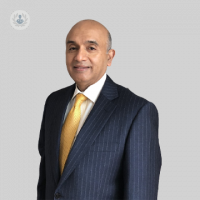ACL reconstruction: ask an expert
Written in association with:ACL tears can occur rather frequently, particularly in people who play sports. Expert consultant trauma and orthopaedic surgeon Mr Dipen Menon provides a guide to the surgery including what is involved and what can and can’t be done following the procedure.

What is ACL reconstruction and what is involved with the procedure?
Anterior cruciate ligament reconstruction is performed for patients who have instability following an anterior cruciate ligament rupture. This procedure is done to improve stability.
It requires an operation during which the surgeon will try to repair any damage to the meniscus (also referred to as the cartilage). If repair fails, the surgeon may have to remove part of the cartilage. The important thing for a successful anterior cruciate ligament reconstruction procedure is prehabilitation.
Patients should work very hard on improving their muscle strength prior to the procedure, and there is a long period of rehabilitation, following the reconstructive procedure.
Is ACL reconstruction painful?
The team of surgeons and anaesthetists will try as much as possible to reduce the pain following the operation. There are various methods that are employed in order to do this. Local anaesthetic is infiltrated into the knee and around the areas where the skin has been cut the skin, and from where the tendon has been harvested. In addition, some anaesthetists will give a block in order to block the saphenous nerve, which is just above the thigh.
This can give pain relief for many hours. Following the operation, the physiotherapist is able to apply cryo cuff or some ice over the wound to try and reduce the pain, as well as painkillers. There is pain following the operation, but it can be well controlled.
What can you do and not do after ACL reconstruction surgery?
When performing ACL reconstruction surgery, I encourage patients to take full weight on their leg immediately after the operation. In the majority of cases, I do not use a brace, but occasionally I will use a brace if I've done a meniscal repair, so that patients can start walking within a few hours of the operation.
We then allow them to gradually perform more exercises on the knee. Initially, patients can perform closed-chain exercises. Subsequently, open-chain exercises can be started after six weeks, under the supervision of a physiotherapist. The patient is encouraged to move the knee early to avoid losing movement to straighten it out and try and fully bend it.
This is done progressively. In the initial phases, there will be swelling. and restriction of movement. Once swelling settles down, movement increases, however, it will take a few weeks to regain movement. Muscle strengthening will commence a few weeks following the operation, and finally balanced proprioception.
After rehabilitation, around nine months to a year following surgery, patients can start training and subsequently try and get back to sports by about 10 months to a year, depending on the type of sport.
What is the success rate of an ACL reconstruction?
The success rate of ACL reconstruction depends very much on the age group of the patient. Usually, for patients who are not very active or into sports, and over the age of 25, success is better in terms of the reduced risk of graft rupture.
Unfortunately, grafts can rupture. This usually occurs in patients aged between 18 – 25. These patients, particularly if they play contact sports, can re-rupture the ligament. However, if the patient rehabilitates well, long-term results are positive, and the risk of re-rupture is low.
Furthermore, sometimes a meniscal tear can occur after a successful repair. This can be within the first six years following a meniscal repair. The overall success rate for ACL reconstruction procedure is high and patients above the age of 25 tend to have strong function, and are able to do the things that they wish to do.
If you require ACL reconstruction and would like to book a consultation with Mr Menon, do not hesitate to do so by visiting his Top Doctors profile today.


